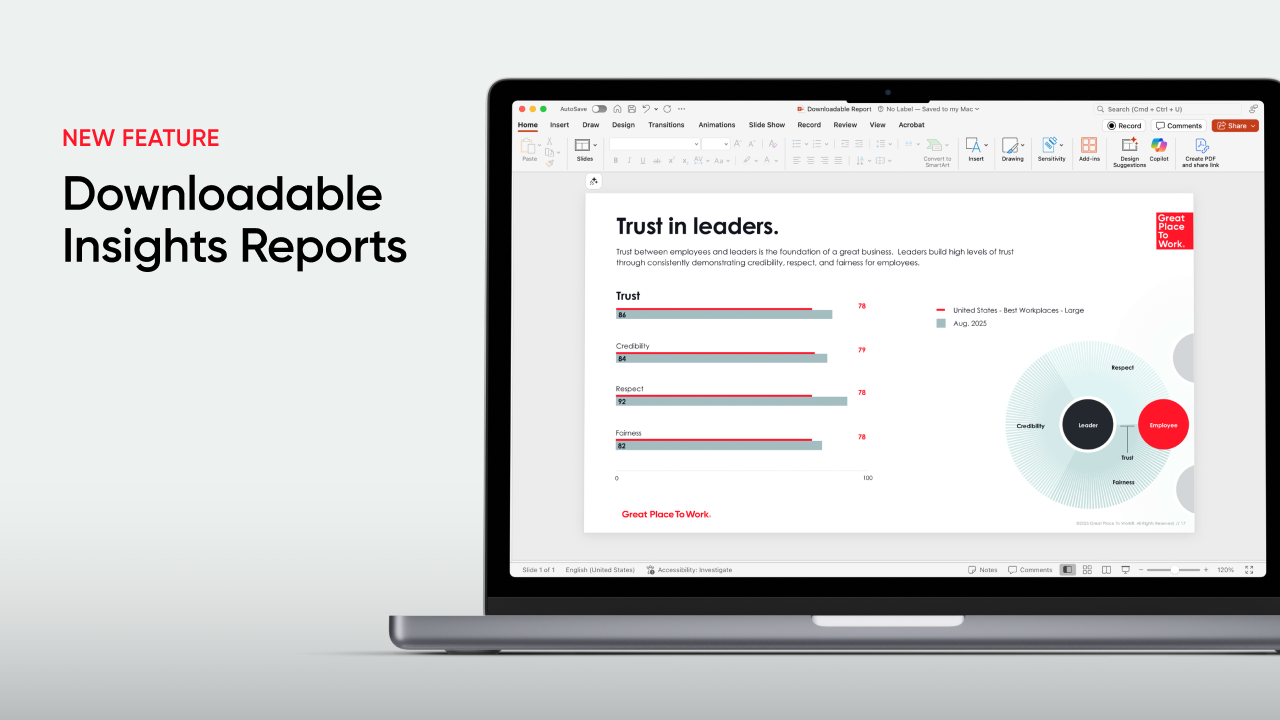Here’s how you can measure productivity and benchmark performance against high-trust workplaces like the Fortune 100 Best.
In the face of challenges ranging from technological disruptions, economic uncertainty, and rising costs, organizations that aren’t committed to continuous improvement and efficiencies risk being left behind.
One way to measure efficiency and increase productivity is to measure how effectively an organization uses its people. McKinsey found that across eight major industries, companies spend at least three times as much annually on talent compared to capital expenses.
Employees represent one of your largest investments and the greatest source of value.
How do you measure that value? Revenue per employee (RPE).
Regardless of industry or company size, RPE provides meaningful insights into the value of one of your most important assets — your people.
What is revenue per employee (RPE)?
Revenue per employee (RPE) is calculated by dividing a company’s total revenue by the number of employees generating that revenue. High-trust workplaces—like those on the Fortune 100 Best Companies to Work For® list—generate 8.5x more revenue per employee than the U.S. public market average. These companies don’t achieve this by cutting headcount—they build cultures of trust that unlock peak performance.
RPE is a powerful metric for understanding how well your organization leverages its most valuable asset: your people. When used alongside other KPIs, it can guide smarter growth strategies and help you build a more resilient, high-performing workplace.
Why RPE is a crucial metric for business leaders
RPE is the ratio of a company’s revenue divided by its total number of employees generating that revenue.
Too often, leaders focus on the costs associated with their workforce, from benefits to recruiting and onboarding. However, employees are also crucial for generating revenue, and RPE can be a meaningful measure of their impact on profitability.
High-trust workplaces have more employees who are able to achieve peak performance. That’s why the Fortune 100 Best Companies to Work For® earned 8.5 times more revenue per employee than the U.S. public market RPE, regardless of industry.
The 100 Best Companies didn’t get there by slashing headcount or cutting costs. These organizations have built a foundation of employee trust that fuels performance in all areas of their business for all people. When more employees thrive, companies reap the benefits.
How to calculate revenue per employee
Revenue per employee is simply the ratio of a company’s revenue divided by the total number of employees generating that revenue. This metric can be applied to large companies or small ones across any industry.
Although it doesn’t capture the full picture, RPE is a meaningful tool for understanding how employees contribute to:
Productivity — RPE is a useful performance metric to understand how much money each team member generates for the company over a period of time. This number not only highlights organizational productivity but can help improve leadership effectiveness and create a high-trust environment where people feel inspired to do their best work.
Efficiency — RPE helps assess how efficiently your workforce generates revenue, which creates higher profits. RPE can help you understand if adding new technology, like implementing Gen AI to support customer service, is helping employees become more efficient.
Performance — RPE is a useful metric to measure the performance of employees or teams year over year, or benchmark performance against comparable industry competitors. While external factors can impact RPE, this number can provide valuable insights into workplace culture and might indicate opportunities around employee engagement, retention, and more.
Calculating RPE is simple:
RPE = Total revenue / number of employees
For example, if your company has a total revenue of $5 million and 50 employees, your RPE is:
RPE = $5 million / 50 = $100,000
This calculation can be used monthly, quarterly, or yearly to benchmark performance or to measure the effectiveness of change management processes, such as after an acquisition.
What is a good revenue per employee ratio for an average company?
Revenue per employee will differ from company to company, depending on factors such as the type of industry, operating costs, market opportunities, number of full-time vs part-time employees, or how well established a business is.
However, according to data from 6,000 companies collected by Professor Damodaran from public sources like Bloomberg, Morningstar, and the S&P 500, companies in the public market might typically expect an RPE of $104,030.
Compare this to the Fortune 100 Best Companies to Work For — a list of 100 organizations that outperform their peers on metrics of employee trust measured by Great Place To Work’s Trust Index™ survey. These companies far exceed the typical RPE, with an average RPE of $883,928. This outperformance is true regardless of industry, or whether a company is publicly traded or privately held.
This higher RPE is correlated to other important measures of business success, such as stock market performance. The 100 Best have consistently outperformed the market by 3.5 times over a 27-year period, according to FTSE Russell, the global index and data provider.
How can you improve your revenue per employee (RPE)?
There are temporary ways to improve RPE numbers. Slashing your marketing budget or cutting staff will skew the numbers in the right direction, but for how long?
While leaders at the 100 Best companies understand that sometimes cost-cutting measures such as layoffs are necessary at times, it’s not the solution to sustainable, long-term performance.
It is more impactful for companies to pursue a growth strategy that includes upskilling talent, offering meaningful work, and creating a high-trust workplace where people can innovate.
1. Develop your employees with relevant and meaningful training opportunities
Your people are crucial to improving the RPE ratio. Hiring top talent isn’t enough. Leaders also need to know how to develop and grow employees. Developing — one of the nine high-trust leadership behaviors — means finding the potential in employees that they might not see for themselves.
A skills gap might prevent employees from maximizing their potential, especially in the face of rapid technology changes. Providing opportunities to learn and grow benefits both employees and the employer.
At American Express, No. 4 on the 100 Best list in 2025, a career and development plan is available to all employees via its talent, learning, and performance management platform, “Navigator.” The platform prompts employees to reflect on their career journey and how they want to grow and be supported.
Navigator provides a snapshot of each person’s skills, experience, and strengths, which becomes a crucial tool for having productive conversations about growth opportunities.
Intuit Inc. focuses on training and development for its employees with its biannual “Career Growth Sprint.” This virtual event features keynotes and workshops covering topics such as goal setting, time management, and communication.
Opportunities for meaningful training shouldn’t be limited only to full-time employees. CarMax empowers its hourly employees with individual development plans (IDPs) at every level of the company. Leaders understand that hourly workers are incredibly busy. The solution: Bite-sized, educational videos and the opportunity to practice what they’ve learned with managers.
2. Ensure employees have the right incentives to pursue meaningful goals
How your employees feel about their compensation can have a direct impact on a company’s financial performance.
Take Delta Airlines. At No. 15 on the Fortune 100 Best Companies to Work For® in 2025, it generates 14% more revenue per “seat mile” than its competitors. Such a performance wouldn’t be possible without the commitment of its 100,000 employees who operate in 55 countries globally.
Delta also shares that revenue with its people. Fortune reports that Delta’s profit-sharing program is the most generous of any major U.S. company, and in 2024, employees received about $1.4 billion, equivalent to every eligible employee receiving 10% of their base pay.
3. Take advantage of technology to increase efficiency
When organizations implement new technology to increase efficiency, it frees up employees’ time otherwise spent on routine or lengthy tasks. The cost of not offering employee training and development could run to roughly $163 million per year for a medium-sized S&P 500 company.
Advances like Generative AI promise to remake workflows and help solve complex problems. Companies like Crowe are meeting that opportunity by providing a robust and evolving AI upskilling program. Employees start with a course outlining the basics of generative AI, including learning about ethics and risks. They’re then invited to join Crowe’s “AI Guild,” where they can collaborate with teams, regardless of their role.
PwC makes AI training engaging for employees through “PowerUp,” a gamified curriculum that boosts AI literacy across the workforce. With a live trivia game, employees can participate in quizzes on strategy and other content from PwC’s AI curriculum, earn prizes, and connect with co-workers.
See how the 100 Best are making the most of their opportunities with AI technology.
4. Reduce labor costs by limiting turnover
RPE is influenced by a mix of external and internal factors, including your company’s turnover rate.
Even when faced with layoffs, companies need to hold onto their best employees. That’s because turnover costs organizations in more ways than one. According to the Society for Human Resource Management (SHRM), the real cost of recruitment is three to four times a position’s salary. Organizations lose out on the time managers spend interviewing potential employees, disruption to the team, loss of skills and knowledge, and time spent onboarding and training a new hire.
Companies that make the 100 Best list experience half the turnover of their peers.
What makes an employee want to stay? Great Place To Work surveyed more than 1.3 million U.S. employees and uncovered three common experiences that highly correlate to retention:
- 7x more likely to stay when they say their work is meaningful
- 2x more likely to stay when they report being proud of where they work
- 7x more likely to stay when they say their workplace is fun
Listening and giving employees a voice is a powerful retention strategy. It signifies that your people are vital to the company’s success. Employee engagement surveys are an invaluable tool to get real-time feedback on employees’ thoughts or concerns about the culture before they update their resume and look elsewhere.
5. Unlock innovation
In high-trust workplaces, employees drive higher levels of innovation. While leaders know it’s crucial to include all talent in creating a culture of innovation, there are five hidden obstacles to innovation that could be getting in the way:
- If employees experience anxiety in the workplace, they’re less likely to innovate.
- If employees feel like they’ve been left out of the company’s mission and vision, they feel excluded from innovation.
- When people lack the resources to get their work done, they can’t fully participate.
- Front-line managers are fundamental in driving innovation, yet often feel neglected or under-supported.
- Without the ability to grow professionally, employees feel blocked from contributing new ideas.
The secret to speedier innovation is “Innovation By All”. More inclusive innovation leads to higher revenue. With the best organizations seeing their revenue grow 550% faster than less inclusive organizations, it’s expensive to leave people behind.
Unlock higher RPE with Great Place To Work
Unlocking the full potential of your workforce requires a foundation of trust. That starts with managers who model high-trust leadership behaviors.
Start by surveying employees and using data to identify opportunities for building trust and driving meaningful growth that is reflected in higher RPE.
Explore the Trust Index Survey today and transform your culture into business success.
Elevate employee experience
Ensure your best people thrive and stay. Benefit from continuous culture support and our proven model to keep your team committed.








